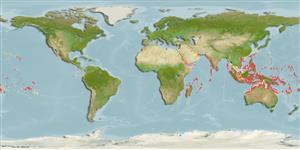Environment: milieu / climate zone / depth range / distribution range
Sinh thái học
Biển Cùng sống ở rạn san hô; Mức độ sâu 1 - 30 m (Ref. 1602). Tropical; 30°N - 28°S
Eastern Indian Ocean: although reported to occur widely in the Indo-Pacific, specimens have only been collected at the Batu Islands, off Sumatra, Indonesia. Western Indian Ocean: Gravid females have been collected from Seychelles Islands (Ref. 45699).
Length at first maturity / Bộ gần gũi / Khối lượng (Trọng lượng) / Age
Maturity: Lm 4.8, range 5 - 5 cm
Max length : 12.0 cm SL con đực/không giới tính; (Ref. 1602)
Các tia vây lưng cứng (tổng cộng) : 0; Các vây lưng mềm (tổng cộng) : 75 - 88; Tia cứng vây hậu môn: 0; Tia mềm vây hậu môn: 59 - 69; Động vật có xương sống: 41 - 45.
Rare species (Ref. 34024) notable for its strict association with true reef environments and particularly so with outer reefs and reef cores (Ref. 81230). An indweller of deep interstices of lagoon and seaward reefs to a depth of at least 30 m (Ref. 1602). Ovoviviparous (Ref. 240). Solitary inhabitant of shallow water, cryptic (Ref 90102).
Ovoviviparous. Sexes can be readily distinguished by the male's intromittent organ and the female's genital pore (Ref. 240, 205). On the basis of this morphology, copulation may involve flexion of the male's body and pumping of sperm into the female (Ref. 240). Embryos are retained in the ovaries until about 6 mm long, deriving nourishment from large yolk sacs, making the species ovoviviparous rather than viviparous (Ref. 240).
Nielsen, J.G., D.M. Cohen, D.F. Markle and C.R. Robins, 1999. Ophidiiform fishes of the world (Order Ophidiiformes). An annotated and illustrated catalogue of pearlfishes, cusk-eels, brotulas and other ophidiiform fishes known to date. FAO Fish. Synop. 125(18):178p. Rome: FAO. (Ref. 34024)
IUCN Red List Status (Ref. 130435)
Threat to humans
Harmless
Human uses
Các công cụ
Special reports
Download XML
Các nguồn internet
Estimates based on models
Preferred temperature (Ref.
123201): 25.5 - 29.3, mean 28.4 °C (based on 3018 cells).
Phylogenetic diversity index (Ref.
82804): PD
50 = 0.7500 [Uniqueness, from 0.5 = low to 2.0 = high].
Bayesian length-weight: a=0.00389 (0.00180 - 0.00842), b=3.12 (2.94 - 3.30), in cm total length, based on all LWR estimates for this body shape (Ref.
93245).
Mức dinh dưỡng (Ref.
69278): 2.6 ±0.1 se; based on diet studies.
Fishing Vulnerability (Ref.
59153): Low vulnerability (10 of 100).
Nutrients (Ref.
124155): Calcium = 138 [75, 245] mg/100g; Iron = 0.922 [0.534, 1.561] mg/100g; Protein = 16.9 [14.3, 19.3] %; Omega3 = 0.11 [0.06, 0.19] g/100g; Selenium = 32.5 [16.6, 73.1] μg/100g; VitaminA = 88.1 [26.6, 286.7] μg/100g; Zinc = 2.24 [1.53, 3.13] mg/100g (wet weight);
